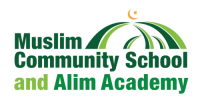The purpose and goals of MCS/AA are the same as they were when the schools were founded: to offer an alternative educational program to the public school system for Muslim families to educate their children in an Islamic environment.
Quran, Arabic and Islamic Studies are offered in addition to the core subjects required by county and state educational graduation requirements so that students can learn to read the Quran and learn about Islam. A continuing effort is made to improve the educational program to enhance the learning capabilities of all students to prepare them for the competitive world outside the doors of our schools. As such, our academic program follows the requirements of the State of Maryland and closely follows the curriculum guidelines used in the Montgomery County public school system. We use the same textbooks as those being used in the public school system.
We have been successful in educating our students. Many have gone on to higher educational institutions and received degrees from colleges and universities. Some former students have returned as teachers after receiving their degrees to show students that they can be successful if they work hard and take their studies seriously.
Our facilities include bright, attractive classrooms as well as a computer lab, a library, a science lab, and an art room. We also have a large auditorium that operates as a multi-purpose room. The student population varies year to year and grade to grade with approximately 130 students. The highest number of students in the history of the school has been 212 students.
Faculty development is an important tool that we use to help teachers improve their teaching skills. We have monthly meetings that focus on many academic issues that rely on best practices in academia such as assessment, curriculum development, professional development, and using technology to support instruction.
We use professional learning communities (PLCs) to focus on learning rather than merely on teaching and to promote collaboration among our teachers in order to help ensure that each and every child is successful. Working through PLCs, teachers work with each other closely to: (1) identify what they want students to learn after each unit, course, or grade level; (2) discuss how they will know if students already understand the material; (3) discuss what they will do if students don’t understand the material, (4) determine what they will do if they already understand, and (5) identify the proven “best practices” that they can use in the classroom to benefit all students.

